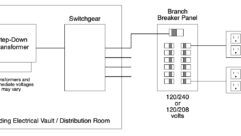Atlantic Power Quality Systems EP15A
Aug 1, 2003 12:00 PM,
John McJunkin
Some people are perfectly willing to spend tens of thousands of dollars on the finest components and thousands more on platinum-plated speaker cables in an effort to achieve a perfect audiovisual experience. They will tweak every available parameter and apply acoustical treatments to their listening environment in order to maximize the quality of the system. One thing that is commonly overlooked, however, is the quality of the power coming from the wall socket. Most people just assume that they have a nice, even 120V all the time. After all, the power company is paid a lot of money to provide stable power, so it should be clean and solid, right? Wrong.
It’s absolutely shocking to discover how radical the fluctuations are in your living room AC. Voltage can drift up and down by 20 or even 30 percent, not to mention available current. Moreover, AC power in the United States is supposed to come in as a clean 60 Hz sine wave. That also turns out to be irregular. There are harmonics, artifacts, and other gnarly noise in the line along with your 60 Hz AC power. Because most consumers only use AC to power things like light-bulbs and blow-dryers, this inconsistency goes unnoticed. Among the ranks of audiophiles, most people don’t consider the negative effect of dirty and unstable power. Even in the realm of pro audio, only a small number of professionals go the extra mile to ensure clean and stable power in their studios. However, power conditioning is becoming more commonplace, and rightfully so, because it has a distinct impact on audio quality.
MOUNT UP, REGULATORS!
Atlantis Power Quality Systems has introduced its EP15A voltage regulator. The term voltage regulator is a bit of an understatement, in that the EP15A does quite a bit more than just regulate voltage. It also guarantees a solid 15A of current at each of its eight low-impedance grounded outlets. Much more impressive, though, is the unit’s ability to clean and correct the 60 Hz sine wave of AC power. The EP15A uses a particularly clever scheme to accomplish this. It has a “pure, amplitude stabilized AC reference waveform” that is phase-locked with the incoming AC. A differential comparator circuit compares the wall AC with the pure sine wave created by the internal oscillator. Any differential is then thrown 180 degrees out of phase, in effect canceling and thus eliminating it. According to the manufacturer, the speed of this process is theoretically unlimited and is therefore capable of eliminating even high-frequency noise and artifacts.
The unit also guarantees the user plenty of available current, an important factor for power amplifiers. Considering the astonishing fluctuations in current created by the existence of motors and other current-robbing devices on the same circuit, this is one of the EP15A’s key features. Although the dedicated audiophile or studio professional may take steps to eliminate such things in his or her own environment, the proliferation of such devices throughout the neighborhood adds significantly to the hash that destabilizes power.
AC power is also susceptible to EMI and RFI, and the EP15A provides filtering to eliminate this type of electromagnetic interference. The unit also provides protection to your equipment in several ways. First, if the wall voltage exceeds 140V, the power to your equipment is simply switched off. This contends with minor spikes in voltage. For radical high-voltage spikes, the entire unit and anything plugged in to it are completely disconnected by a circuit breaker. Likewise, in an undervoltage situation (less than 85V), the circuit shuts down power to your equipment. In the event of overheating (internal heat over 90 degrees), the regulation circuit is hard-bypassed until the temperature comes back down. Also, the regulation circuit is switched out of the path if peak current exceeds 45A, peak to peak.
The EP15A features a two-line, 16-character vacuum fluorescent display that shows output voltage, current, and power (displayed in watts), and the unit sports a handsome brushed aluminum box with stylish highlights. It’s intended for rackmounting, but internal transformers bring its weight up to more than 30 pounds, so a substantial rack is necessary.
THE PROVING GROUNDS
The point of providing clean, regulated power is to improve the quality of the audio provided by a system’s devices. I tested the EP15A’s effectiveness in this regard to see how it stood up. Although the conditioner ostensibly enhances the quality of video, as well, the scope of this test was limited to audio. I chose the A room at the Conservatory of Recording Arts and Sciences in Tempe, Arizona, for the test. This is a traditional live-end, dead-end room with diffusion and bass traps tuned for a pair of Genelec 1031A monitors. On the day of the test, a group of professional audio engineers and students were brought in to make subjective commentary. The point of having both professionals and students was to get trained and untrained listening perspectives for comparison. The musical selection was a final mix that had been completed that day. The students and instructors had heard it with no power conditioning at least two dozen times on the Genelecs, so they were quite familiar with the selection.
To the credit of the EP15A, both seasoned professionals and young engineering students generally agreed on what they heard in the A/B comparison. The music was played for the listening panel both with and without power conditioning. The most noticeable distinction provided by the conditioned power was in the low end: the bass was much more distinct and tight with power conditioning. There was no significant boost in the low end, but all listeners noted a fullness that could be attributed to the presence of extended harmonics. My personal assessment of the low end was that it was full but not tubby.
The other major distinction was in the high end. The enhancement was more subtle but significant nonetheless. Most listeners, particularly the students, commented that the vocal (which was an alto female) seemed brighter. The EP15A also seemed to expand the stereo image and clarify both early reflections and extended reverb tails without a significant increase in the perceived length of the tails.
One distinction bearing mention is that in the power-conditioned playback, the backing female vocals were a bit thinner, which was a positive attribute in this mix. These vocals were in the 250 to 500 Hz range and were overbearing with no conditioning. Part of the upper-end tubbiness of these vocals can be attributed to the fact that they had been recorded to 24-track two-inch analog at five over. Many of the other instruments in the mix had been recorded to 24-bit, 48 kHz digital, so the mix was a hybrid. Regardless, the power conditioning had the effect of clarifying that frequency range, thus contributing to the clarity of the mix in general. The best subjective description I can provide is that the phase coherency of the broadband was improved, particularly so in the low and low-mid domains.
POWERAGE
The EP15A is a quality product that provides clean, stable power. Although most contractors will likely sink more capital into other products that have a more profound impact vis-à-vis increased audio quality, this product is a fine addition that positively impacts the listening experience. At a retail price of $1,995, this is a device that will more likely be found on the racks of home-audio enthusiasts and audiophiles but is also useful in certain industrial applications, as well.
John McJunkin is the principal of Avalon Audio Services in Phoenix. For more than 20 years, he has engaged in studio recording, live sound, and broadcast, and he consults in design and commission for numerous studios and artists.
SPECIFICATIONS
Input Voltage Range 90 to 135 VRMS
Nominal Output Voltage, 1 Amp to 15 Amps
120 VRMS with 1 percent tolerance
Lowpass Filter Dynamic, not passive
Protection Overvoltage, overtemperature, overcurrent, undervoltage
Peak Repetitive Output Current
46A peak to peak
Weight 30 lb.
Dimensions (W×H×D) 17.0″×3.5″×14.2″
Surge Protection 300 Joules, 6,500 Amps
Other Options 19″ rackmount
PRODUCT SUMMARY
Company: Atlantis Power Quality Systems, www.exactpower.com
Product: EP15A
Pros: Provides clean, stable power. Some improvement to audio quality.
Cons: Not suitable for those looking for a profound impact on audio.
Applications: Home audio installs and some industrial applications.
Price: $1,995










